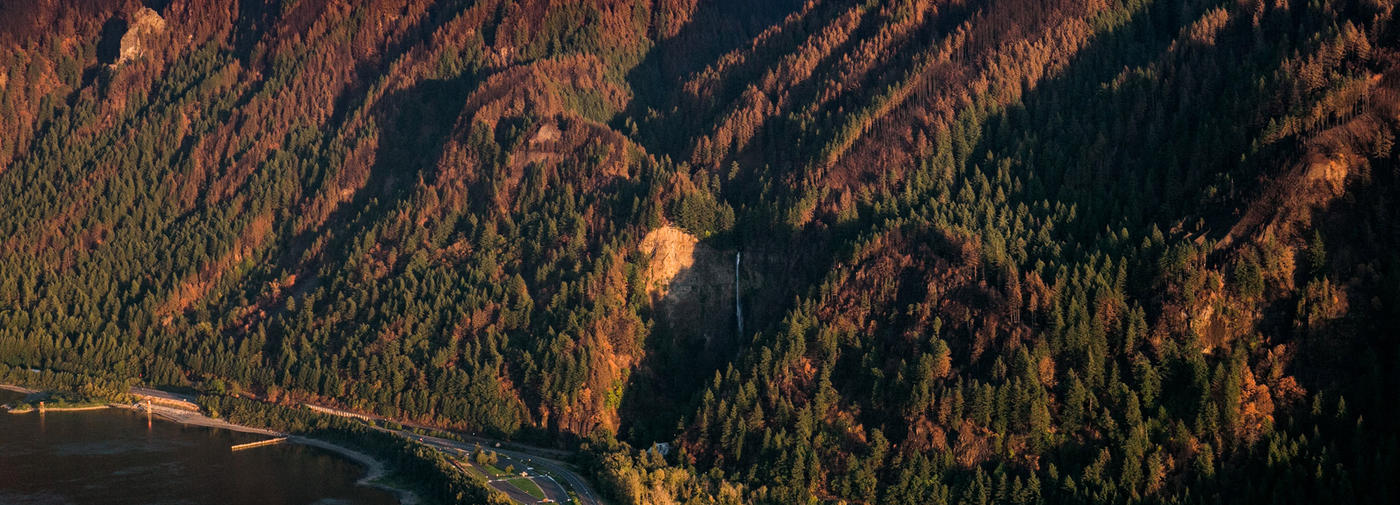Eagle Creek Fire: Frequently Asked Questions
Updates on an evolving situation and ways you can help

Eagle Creek Fire General FAQ & Resources
On Sept. 2, 2017, a fire started along the Eagle Creek trail in the Columbia River Gorge National Scenic Area. Fueled by vegetation that had not experienced rain in 83 days, the fire quickly took hold and spread to over 48,000 acres—jumping the Columbia River and scorching healthy forests in both Washington and Oregon.On Nov. 30, 2017 the fire was declared 100 percent contained by the U.S. Forest Service. No lives were lost, just four buildings were destroyed, and the forest now appears to be a mosaic of green and burned landscapes.
We have a long journey ahead, but the Gorge is a resilient place. Communities will recover, wild areas will rebound, and Friends of the Columbia Gorge will be working harder than ever to ensure that community voices and opinions are taken into account when creating the policies and programs needed to help the Gorge thrive.
Eagle Creek Fire General FAQ
How badly was the Gorge burned? Where can I find a map of the burned area? Where can I find more information on the fire's impacts?
The fire jumped around, creating a mosaic pattern with partially burned areas, untouched green areas and areas that were completely burned. More information on the soil burn severity can be found in the U.S. Forest Service's Fall 2017 Burned Area Emergency Response report. The 49,000-acre containment area can be viewed on this U.S Forest Service map. The Forest Service has also launched a page dedicated to ongoing trail damage assessments.
What can be done to help restore trees lost in the fire?
The first step is for scientists and other specialists to properly assess the ecological damage and make recommendations on specific actions that could help the area rebound naturally. Since the fire has burned in a mosaic pattern, there may be very different biodiversity impacts at different locations and elevations.
The Gorge is protected as a federal National Scenic Area, and any post-fire efforts must be conducted in conjunction with the U.S. Forest Service and partner agencies. This includes activities to mitigate the spread of invasive species, plants that could threaten native Gorge fauna.
What has Friends done so far in response to the fire?
Friends' immediate response to the Eagle Creek wildfire focused on three main fronts: assisting partners; helping educate the public; and advocating for the policies and programs needed to aid Gorge communities and begin to address long-term recovery efforts.
Longer term, Friends is calling for a Gorge Resilience initiative to restore, rebuild, and rejuvenate the Columbia Gorge. Gorge Resilience would work to heal the land, rethink the Gorge’s trail and transportation systems and support Gorge communities as they recover economically from the fire.
Will post-fire clear-cut logging help the ecosystem recover?
No. Many studies have been conducted on forest fires and logging and there is no strong, scientific evidence of an ecological benefit from clear cut logging in a post-fire environment. In fact, clear cut logging can be highly disruptive to the natural recovery processes because it negatively impacts surviving organisms and structures in disturbed areas and on vegetation that re-establishes naturally following the disturbance. Therefore, clear-cut logging is completely inappropriate for the Columbia River Gorge.
Resources & Ways to Help
Volunteer
Gorge Trails Recovery Team | Friends has teamed up with Trailkeepers of Oregon, Pacific Crest Trail Association, and Washington Trail Association to roll out a series of trail building and stewardship work parties this spring and summer along with trainings and courses to prepare volunteers. Learn more about the team's work and how you can get involved.Volunteer to Be a Trailhead Ambassador | Join Friends this spring and summer along with the Mt. Hood and Columbia River Gorge Regional Tourism Alliance and the U.S. Forest Service to educate hikers at popular trailheads throughout the Gorge and Mt. Hood. We're looking for out-going volunteers to answer hiker and Eagle Creek fire related questions, promote responsible hiker ethics like Leave No Trace, and highlight Ready, Set, Gorge.
Hike Responsibly
Favorite Gorge Trail Closed? Find a Different Hike | While 135 miles of trails remain closed to the fire, there are many trails and recreation areas still open to explore within the Gorge and neighboring areas.Stay out of the Burned Areas | Do your part in letting the burned trails recovery naturally. Please obey all closures as there is a high risk of landslides and rockfall currently. Citations are being issued to tresspassers.
Help Support Gorge Communities
Show the Gorge Some Love | Gorge communities impacted by the fire need our ongoing support. They help make the Gorge a wonderful place to visit. We encourage you to reconnect with the Gorge communities.Cascade Locks Strong | Businesses in Cascade Locks, OR have been especially hit hard by the fire and its associated evacuations and road closures. Buy gift certificates now and make a commitment to come back to support Gorge communities as they recover from the losses incurred due to the Eagle Creek fire.
Get Involved
Why Clear Cut Logging is Wrong for the Gorge | Learn more about Rep. Greg Walden's pending legislation (H.R. 3715) that could undo over 100 years of conservation protections in the Gorge.Sixteen Ways to Get Involved | From protecting and enhancing the landscapes and trails of the Gorge to volunteering as first responders when people are in need of help, read local author Laura O. Foster’s blog to learn how you can help give back.
